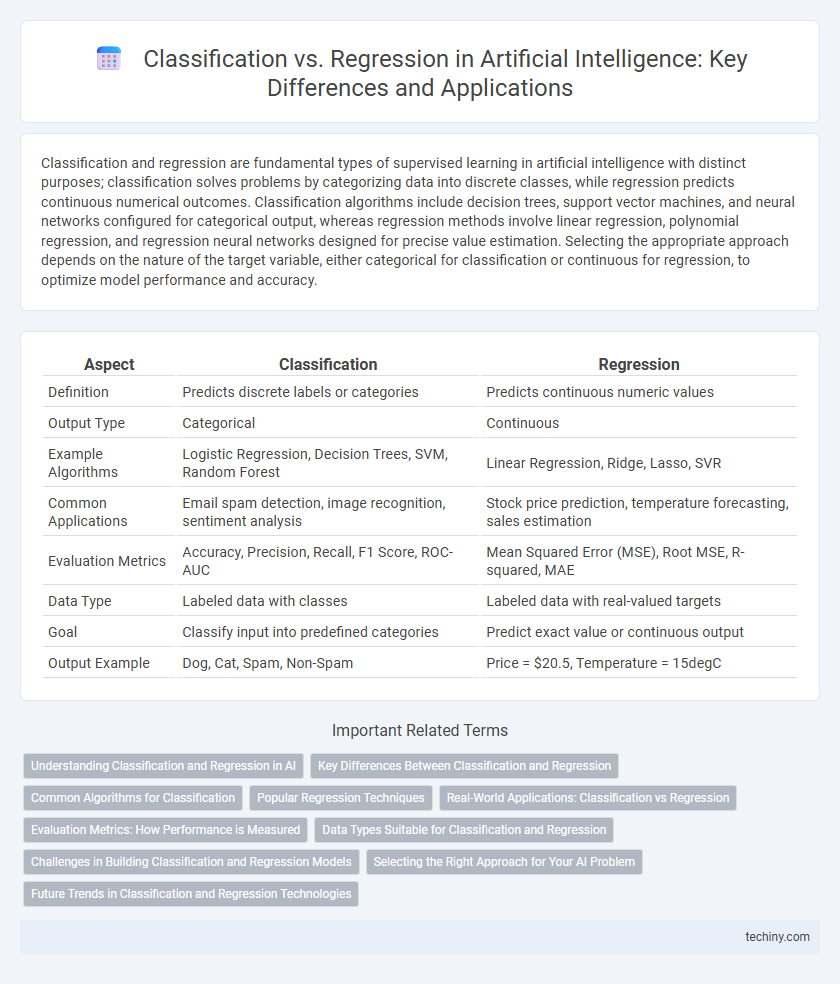Classification and regression are fundamental types of supervised learning in artificial intelligence with distinct purposes; classification solves problems by categorizing data into discrete classes, while regression predicts continuous numerical outcomes. Classification algorithms include decision trees, support vector machines, and neural networks configured for categorical output, whereas regression methods involve linear regression, polynomial regression, and regression neural networks designed for precise value estimation. Selecting the appropriate approach depends on the nature of the target variable, either categorical for classification or continuous for regression, to optimize model performance and accuracy.
Table of Comparison
| Aspect | Classification | Regression |
|---|---|---|
| Definition | Predicts discrete labels or categories | Predicts continuous numeric values |
| Output Type | Categorical | Continuous |
| Example Algorithms | Logistic Regression, Decision Trees, SVM, Random Forest | Linear Regression, Ridge, Lasso, SVR |
| Common Applications | Email spam detection, image recognition, sentiment analysis | Stock price prediction, temperature forecasting, sales estimation |
| Evaluation Metrics | Accuracy, Precision, Recall, F1 Score, ROC-AUC | Mean Squared Error (MSE), Root MSE, R-squared, MAE |
| Data Type | Labeled data with classes | Labeled data with real-valued targets |
| Goal | Classify input into predefined categories | Predict exact value or continuous output |
| Output Example | Dog, Cat, Spam, Non-Spam | Price = $20.5, Temperature = 15degC |
Understanding Classification and Regression in AI
Classification and regression are fundamental techniques in artificial intelligence used to predict outcomes based on input data. Classification assigns data points to predefined categories or classes, making it ideal for tasks like image recognition or spam detection. Regression predicts continuous values, such as forecasting stock prices or estimating house values, by modeling relationships between variables.
Key Differences Between Classification and Regression
Classification predicts discrete labels or categories, such as spam detection or image recognition, by assigning inputs to predefined classes. Regression estimates continuous numerical values, like predicting house prices or temperature, based on input variables. Key differences include the output type--categorical for classification and continuous for regression--and evaluation metrics, where classification uses accuracy or F1-score and regression relies on mean squared error or R-squared.
Common Algorithms for Classification
Common algorithms for classification in artificial intelligence include decision trees, support vector machines (SVM), k-nearest neighbors (k-NN), and logistic regression, each designed to assign labels to discrete categories based on input features. Ensemble methods like random forests and gradient boosting enhance classification accuracy by combining multiple base learners. Neural networks, particularly deep learning models, excel at handling complex classification tasks involving high-dimensional data such as images and text.
Popular Regression Techniques
Popular regression techniques in artificial intelligence include Linear Regression, which models the relationship between dependent and independent variables with a straight line, and Support Vector Regression (SVR), known for its robustness in high-dimensional spaces. Decision Trees and Random Forests are widely used for their ability to handle non-linear data patterns and reduce overfitting through ensemble learning. Additionally, Neural Networks provide powerful capabilities for capturing complex relationships in regression tasks due to their deep learning architecture.
Real-World Applications: Classification vs Regression
Classification algorithms power spam email detection by categorizing messages as spam or non-spam, while regression models predict housing prices by estimating continuous values based on features like square footage and location. In medical diagnosis, classification distinguishes between disease presence or absence, whereas regression forecasts patient recovery time or dosage requirements. E-commerce platforms use classification to segment customers for targeted marketing and regression to predict sales trends and inventory needs.
Evaluation Metrics: How Performance is Measured
Classification evaluation metrics primarily include accuracy, precision, recall, F1 score, and the area under the ROC curve (AUC-ROC), which measure the model's ability to correctly categorize discrete labels and handle class imbalance. Regression performance is quantified using metrics such as mean squared error (MSE), mean absolute error (MAE), root mean squared error (RMSE), and R-squared, reflecting the model's accuracy in predicting continuous numerical outcomes. Selecting appropriate metrics aligns with specific problem goals, ensuring meaningful interpretation of artificial intelligence model effectiveness.
Data Types Suitable for Classification and Regression
Classification algorithms are best suited for categorical data, including nominal and ordinal variables, where the goal is to assign discrete labels or classes. Regression techniques excel with continuous numerical data, aiming to predict a quantity or value based on input features. Understanding the nature of the dependent variable--categorical for classification and continuous for regression--is essential for selecting the appropriate supervised learning model.
Challenges in Building Classification and Regression Models
Classification models face challenges such as handling imbalanced datasets, selecting relevant features, and managing noisy or overlapping class boundaries that reduce accuracy. Regression models often struggle with multicollinearity, heteroscedasticity, and capturing nonlinear relationships between variables that impact prediction reliability. Both approaches require careful tuning of hyperparameters and robust validation techniques to avoid overfitting and ensure generalizability.
Selecting the Right Approach for Your AI Problem
Classification and regression are fundamental supervised learning techniques in artificial intelligence, distinguished by their output types: classification predicts discrete labels, while regression forecasts continuous numerical values. Selecting the right approach hinges on analyzing the target variable's nature--categorical data demands classification models such as decision trees or support vector machines, whereas continuous data requires regression algorithms like linear regression or neural networks. Understanding the problem domain and dataset characteristics ensures optimal model choice, boosting accuracy and performance in applications ranging from image recognition to financial forecasting.
Future Trends in Classification and Regression Technologies
Advancements in classification and regression technologies are increasingly driven by deep learning architectures and automated machine learning (AutoML) frameworks, which enhance model accuracy and efficiency. Future trends emphasize the integration of explainable AI to improve transparency and trust in predictive outcomes across domains such as healthcare, finance, and autonomous systems. Emerging techniques in transfer learning and hybrid models are expected to revolutionize classification and regression tasks by enabling adaptive learning from limited or evolving datasets.
Classification vs Regression Infographic

 techiny.com
techiny.com